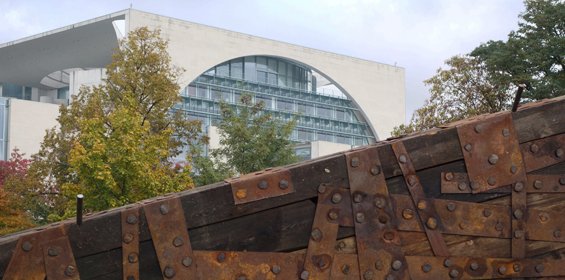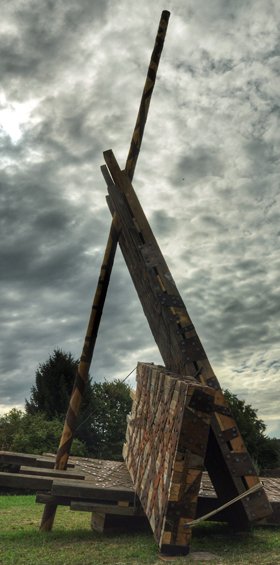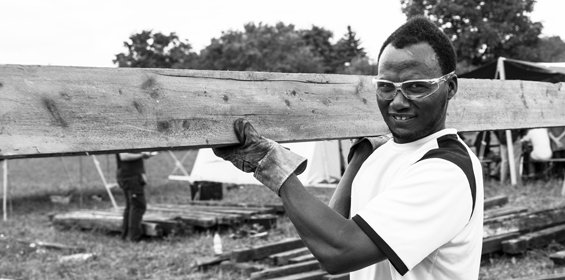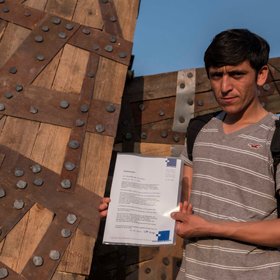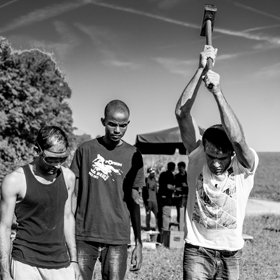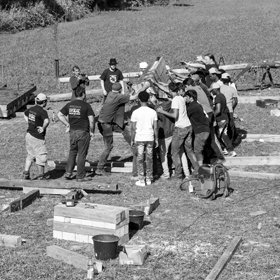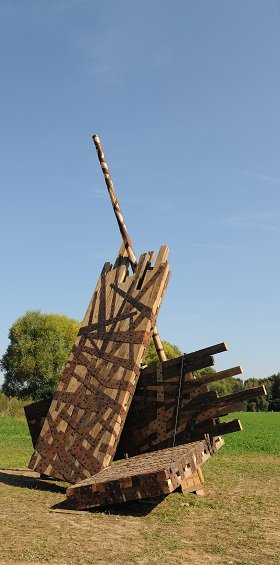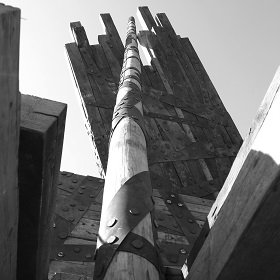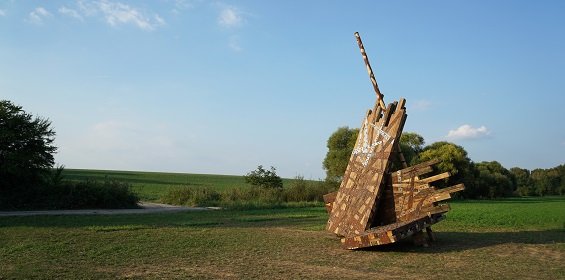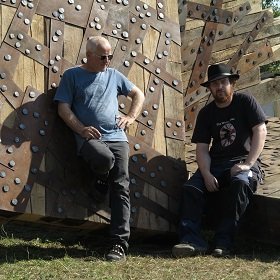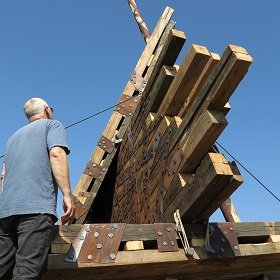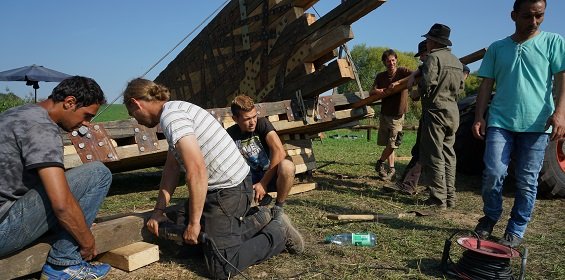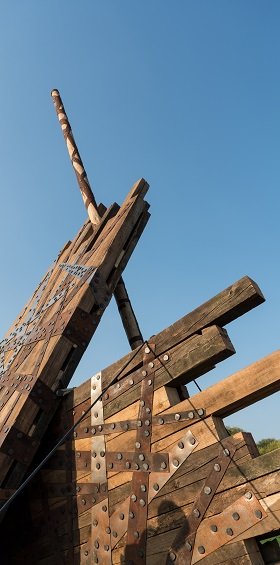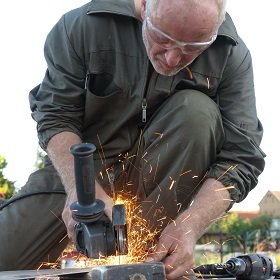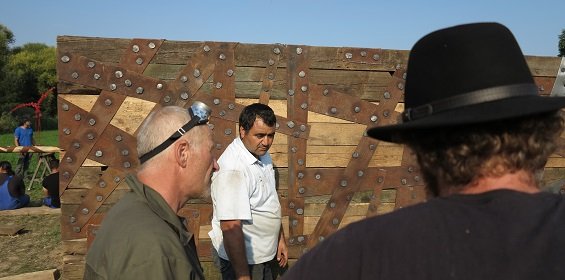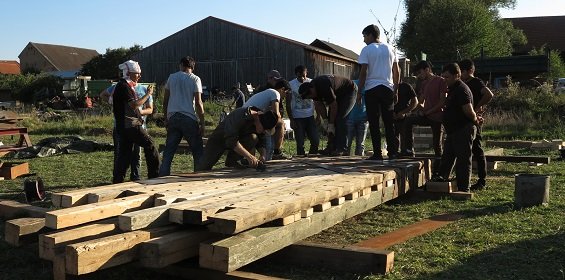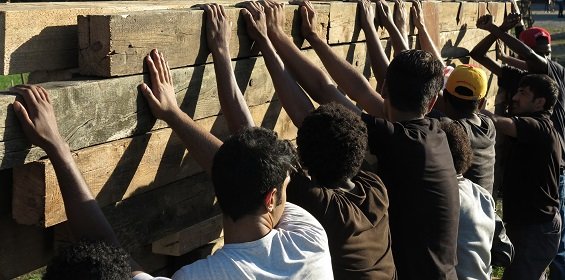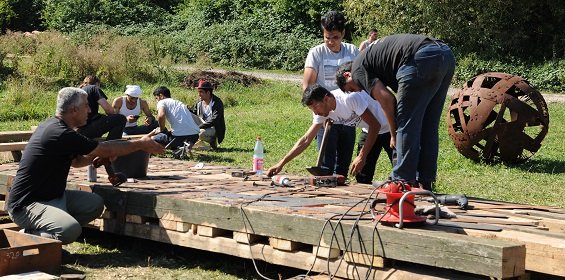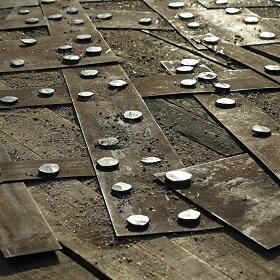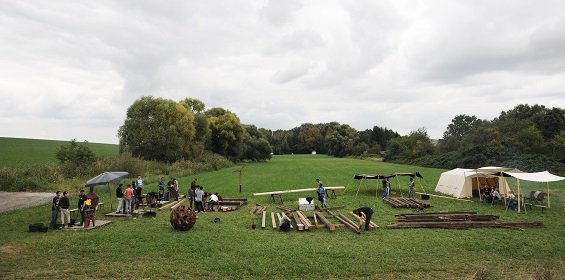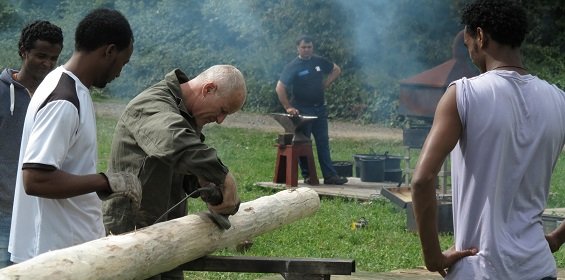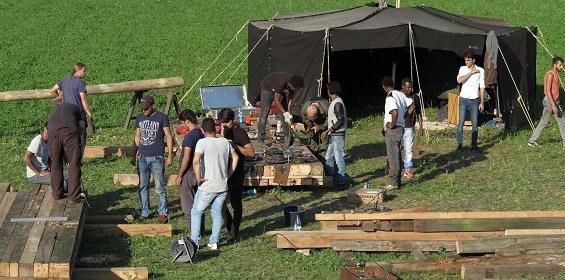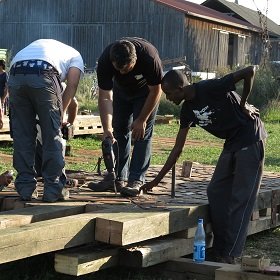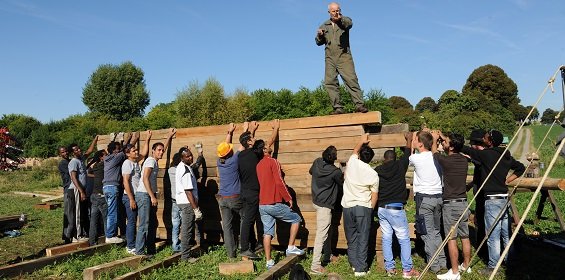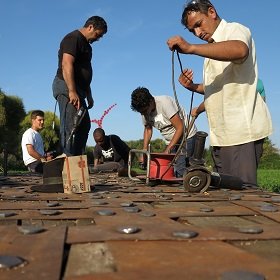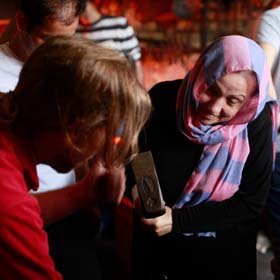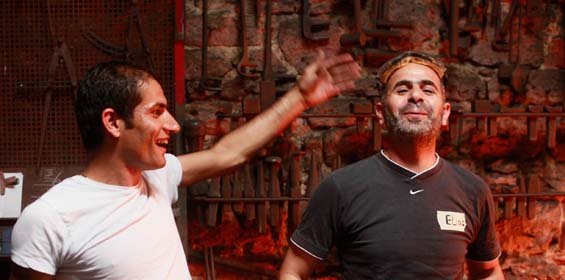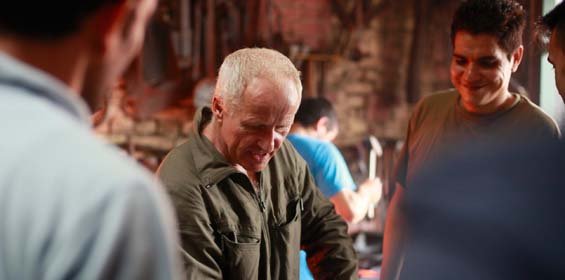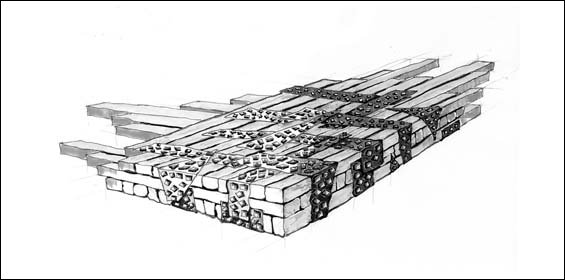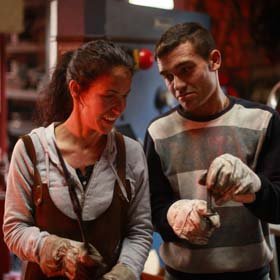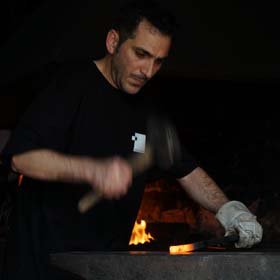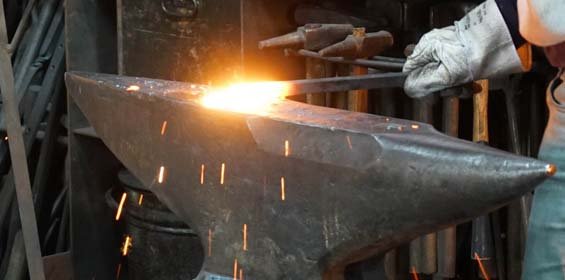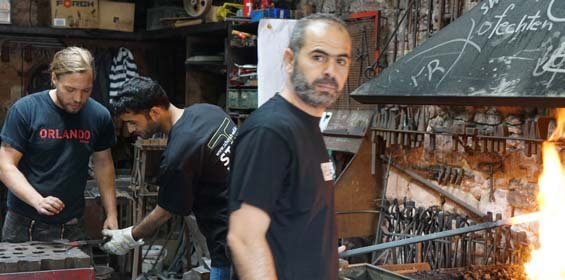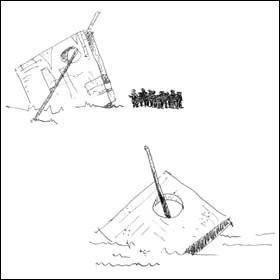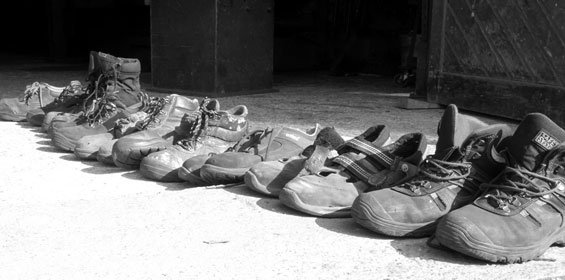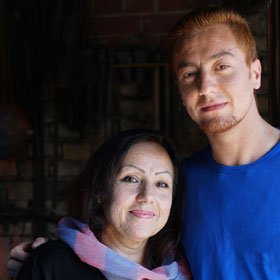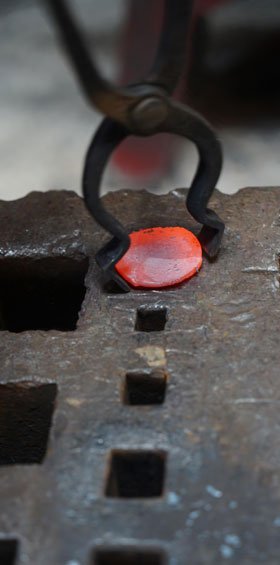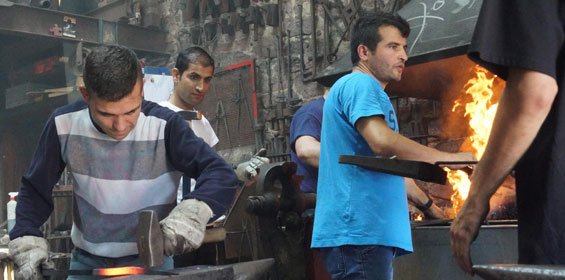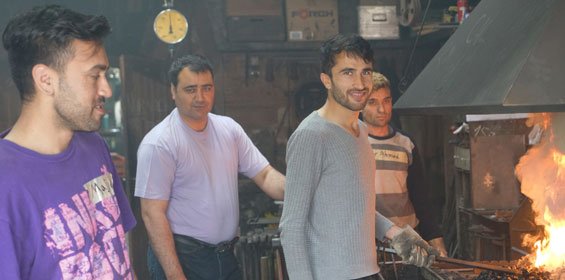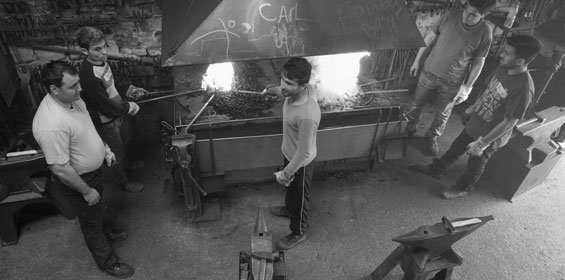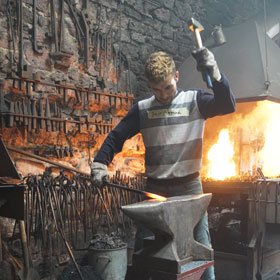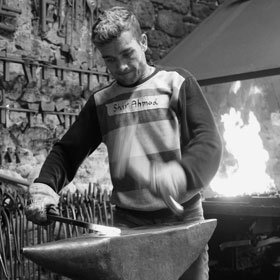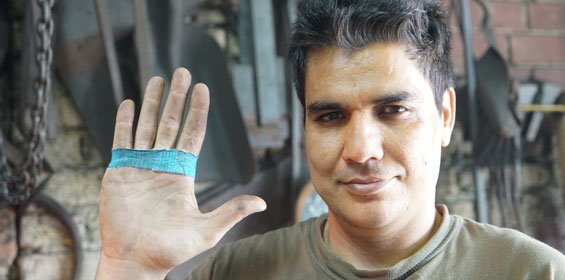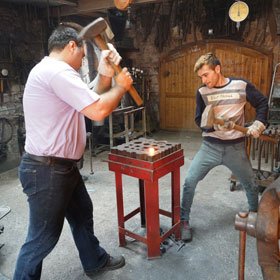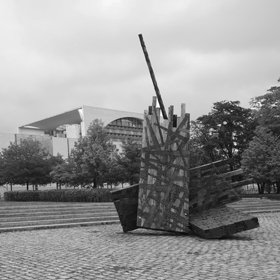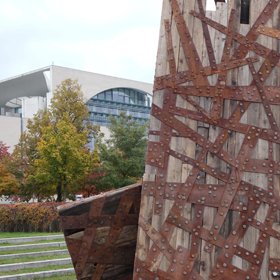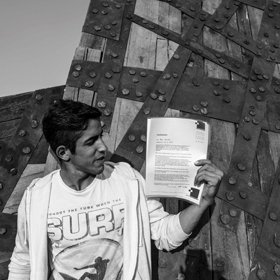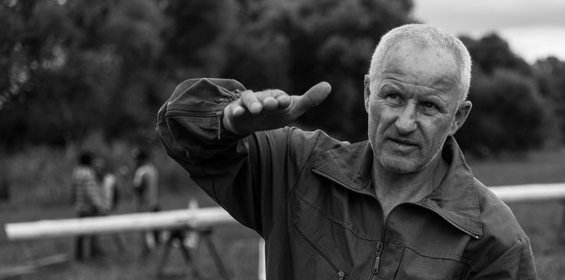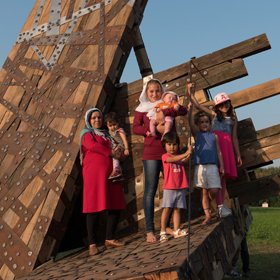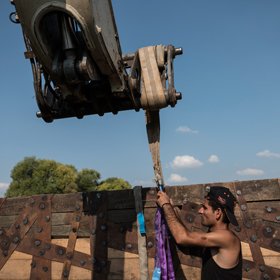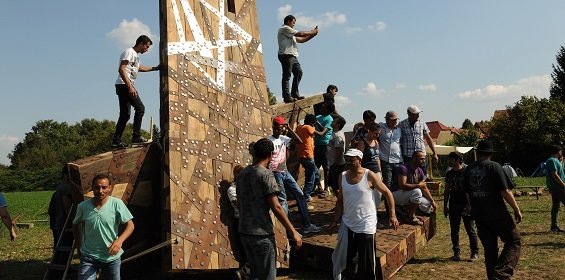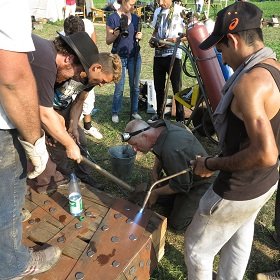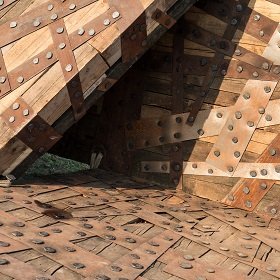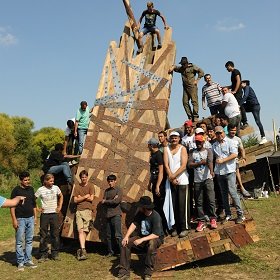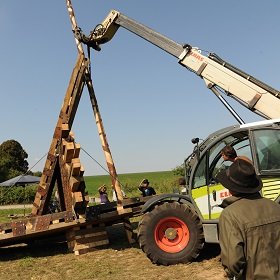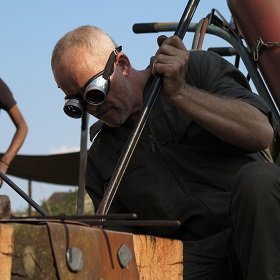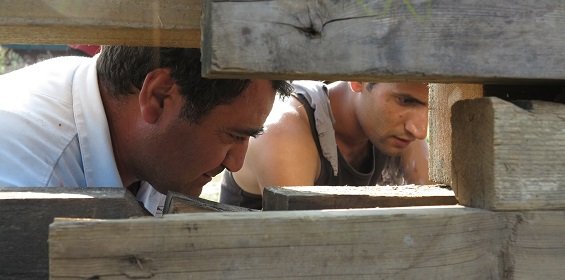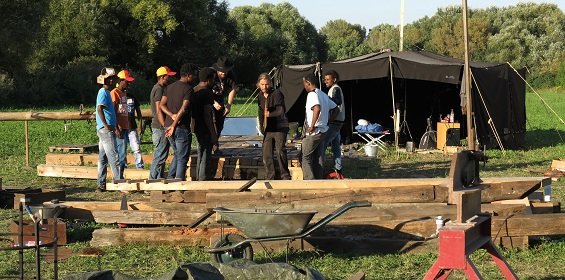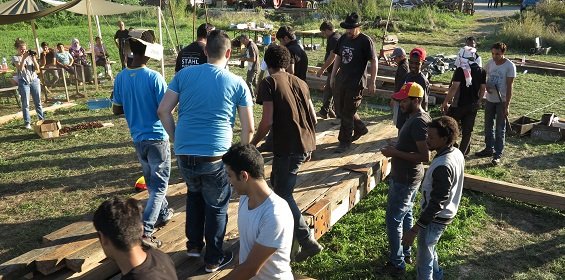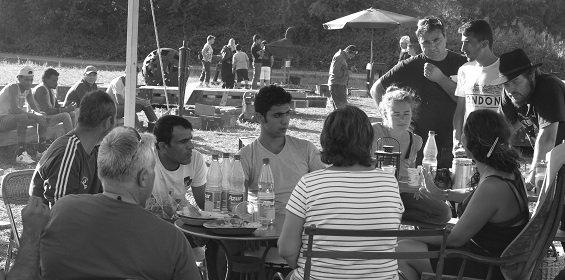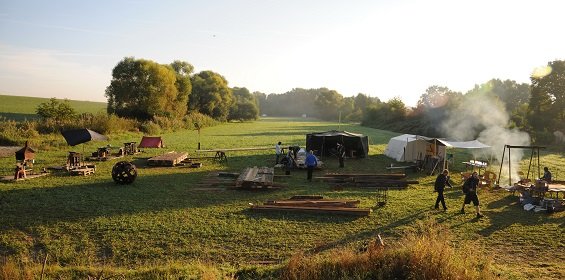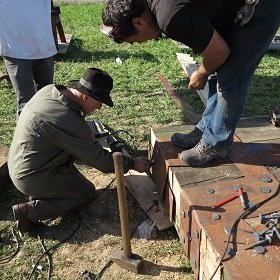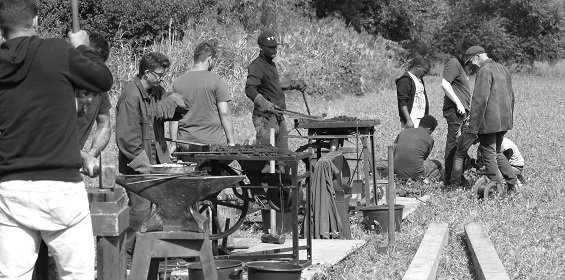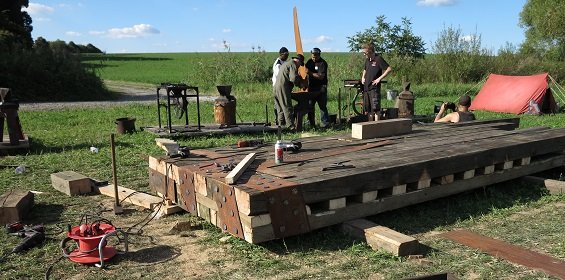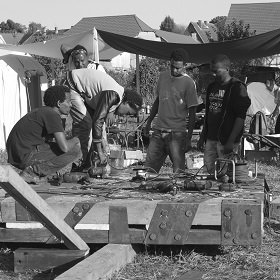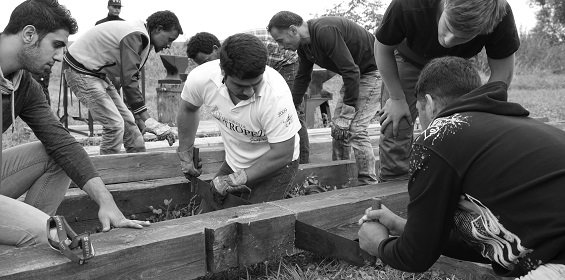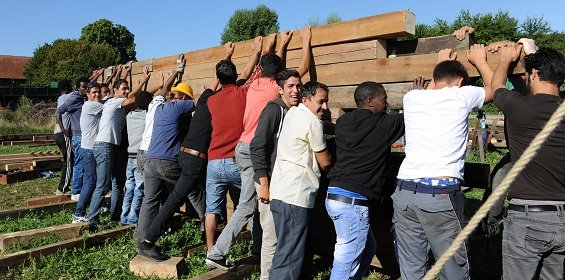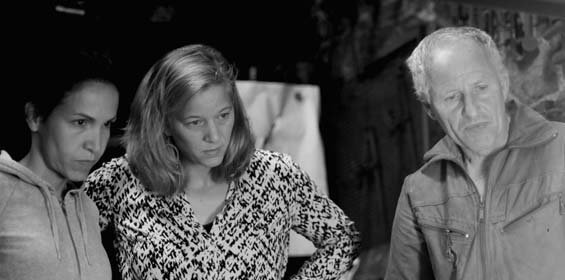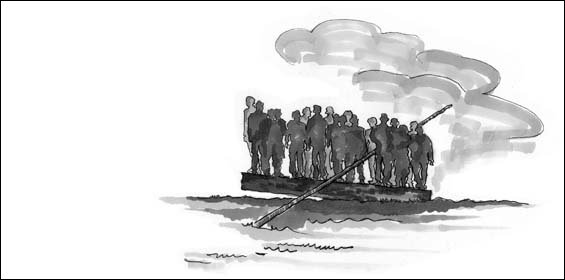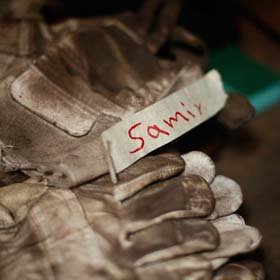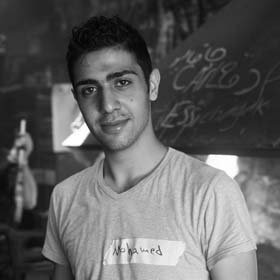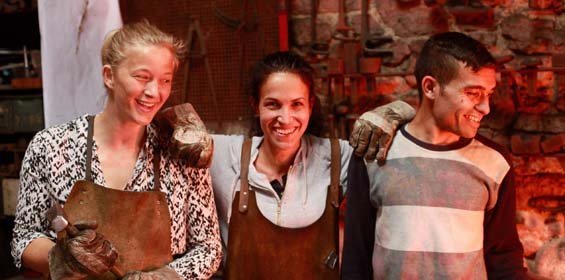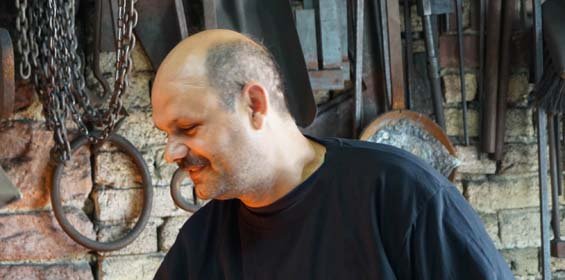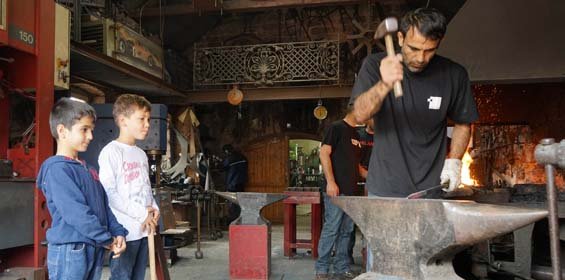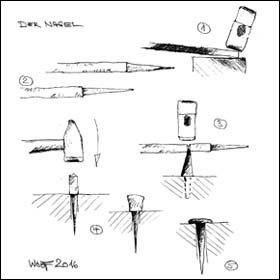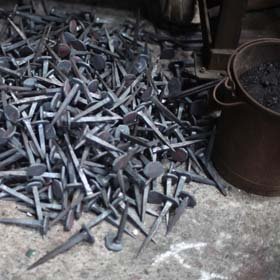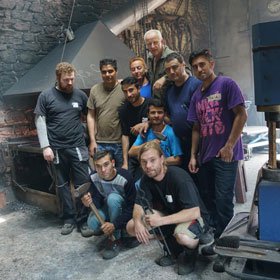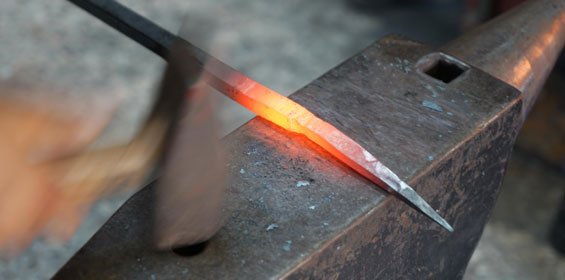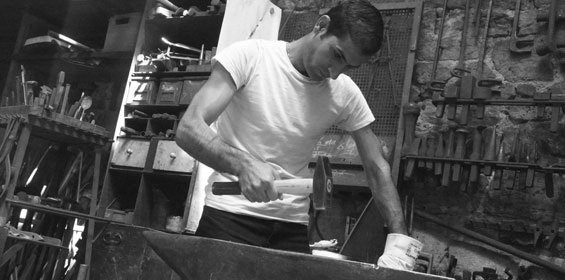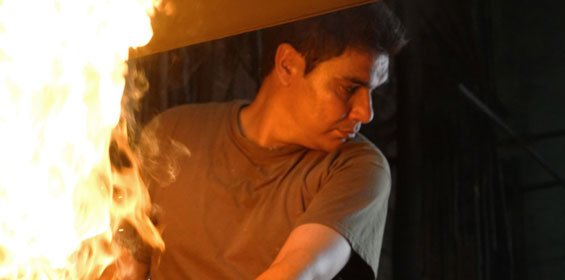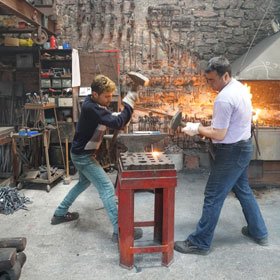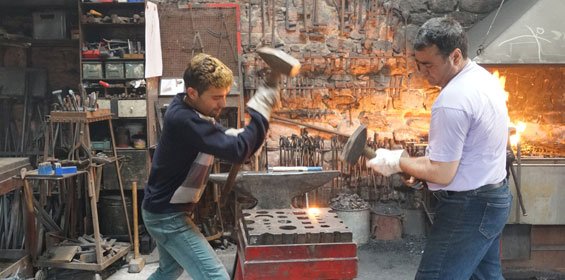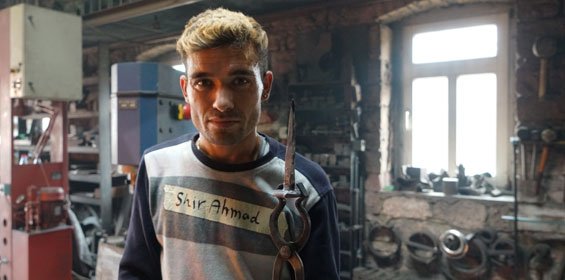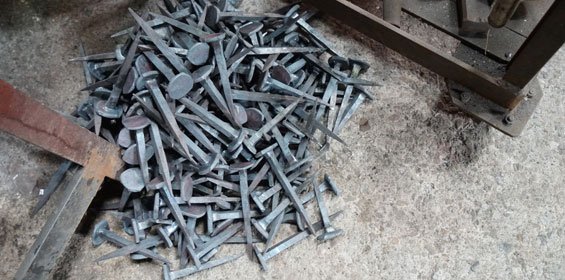ODYSSEE
Integrative Art Performance
Every morning the workshop at the ancient smithy in the small town of Habitzheim close to Frankfurt is filling the air with the hammering sounds of steel construction. For several years, the rhythmical beating of iron on iron has been resounding through the old walls. For a few weeks though various voices are blending in. Arabic, Urdu and Dari is mixing into German, which is usually spoken here. The forge, normally being used by a foreman and his assistants to realize commissioned pieces for churches, monuments and private clients has opened its doors for a special project for the duration of four months.
Since May 2016, the sculptor Georg-Friedrich Wolf is creating a sculpture together with refugees from the local shelters. His artwork made from old barrels and wood will be the result of the joint effort of German locals and refugees from different middle eastern countries, orchestrated by the artist, who himself once started out as a blacksmith in a similar workshop.
Until early September, women and men of any age and background are invited to take part in this exceptional project. They heat up the iron bars in an open fire of more than a thousand degrees Celsius, sharpen the end through beating them between anvil and hammer, and then in pairs shape a nail head with alternating strikes.
Occasionally, an inhabitant of the surrounding villages hesitantly enters the workshop. Everyone introduces themselves and a conversations starts - using hands, feet and some bits and pieces of newly learned German.
The visitor gets handed a leather apron and is taught how to forge a nail, like all the others were before him. Hundreds and thousands of nails pile up in a corner of the workshop testifying to the endless hours spent here.
Falk, one of Wolf’s assistants, is standing at an anvil in the corner, noting names of attendees: Basir, Ahmed, Paul, Layla - everyone engraves their forged nail with their name, undeniably becoming part of the artwork itself.
The art performance will reach its climax during the second week of September, when the thousands of forged nails will find their purpose. With the help of iron stripes they will hold the heavy wooden beams of the sculpture. Little by little, Wolf and all those who have returned to erect the construction, will build a massive raft.
Although there will be an actual physical object at the end of the project, Wolf describes this piece as a performance, because the construction as a group and the months of forging are the core of his artwork. Every refugee taking part receives a certificate in the end in order to help her or him gain a foothold on the German labour market.
The artist is certain that the experience to have worked in a regional business, the contacts that are made here and the positive call to action, helps everyone involved with finding their way in this new country and these desperate times. A peek into the workshop confirms everyone’s enthusiasm in taking part in the project and the work they are doing, the part they are playing.
The severity of the often empty day to day life in the refugee homes is being defied here, even during the Ramadan, which is making physical labour especially demanding. Wolf wants to give as many people as possible the opportunity of - literally - being on board of his project. “This is going to be a huge sculpture and nobody will be able to deny its effect“, he says proudly.
Wolf is adamant that projects like this make a difference standing up to the disparity of the refugee crisis in Europe. “Of course we aren’t capable of solving greater problems but that is not what we are trying here anyway. The greatness of art lies in the fact that it is not solution-oriented but has a meaning in itself. If we find ourselves in a helpless situation, we have to do something seemingly senseless in order to stay in motion, not to stagnate and to assure ourselves of our human nature.“
Everyone participating here understands and feels it. With every beat of the hammer, barriers of communication are literally being battered, everyday worries and anger dismantled and optimism created.
“It is essential that we do not treat the migrants as guests who can be sent back anytime,“ says Wolf. Germany is a country of immigration and we need to tackle these challenges together.
Odyssee is not a charity project but a collective effort. This is why art enthusiasts are being invited to sponsor nails for the sculpture. There is a limited edition of 25 signed nails. Sponsoring more than ten nails will get you one of those rarities for your own collection.
PHASE I
Nach genauer Planung in Zusammenarbeit mit den Behörden ist es Wolf seit dem 1. Mai 2016 möglich, Interessierte aus den lokalen Flüchtlingsheimen zu einem Praktikum einzuladen. Dazu stellt er jeweils Vierer-Gruppen zusammen. Da die meisten Teilnehmer Sprachkurse besuchen, lernen sie für jeweils einen halben Arbeitstag in den Betriebsräumen des Wolf’schen Stahlbaubetriebes an Schmiede und Amboss.
Alle Beteiligten schmieden vor allem große eiserne Nägel. Dieser Arbeitsgang ist in ein bis zwei Tagen erlernt. Im Team wird das Gelernte angewandt, verfeinert und optimiert. Die Teilnehmer erhalten einen ersten Eindruck über einen klassischen deutschen Betrieb und bekommen Techniken der Metallverarbeitung vermittelt.
Am Ende dieser Phase erhält jeder Teilnehmer ein qualifiziertes Arbeitszeugnis. Durch den Kontakt zu den Mitarbeitern setzt Wolf eine erste Kommunikation in Gang. Die Teilnehmer stammen aus unterschiedlichen Ländern und verstehen und sprechen kaum Deutsch. Doch die non-verbale Verständigung, die in einer Werkstatt mit entsprechender Arbeitslautstärke üblich ist, lässt diese Sprachschwierigkeiten in den Hintergrund treten und gibt somit dem Geist des gemeinsamen Schaffens mehr Raum.
Im Verlauf des Sommers lässt Wolf eine große Anzahl von Teams diesen Prozess des Nagelschmiedens durchlaufen. Auch Außenstehende, Freunde oder Familie, sowie jeder interessierte Bundesbürger ist eingeladen hinzuzukommen, um mit der Gravur des eigenen Namens in einem selbst geschmiedeten Nagel aktiv an Werk und Kommunikation zu partizipieren.
PHASE II
Die viermonatige Ausbildungsphase wird Anfang September 2016 in zwei gemeinsamen Arbeitswochen münden, während dieser alle Beteiligten gemeinsam unter Wolf’s Leitung eine Skulptur in Form eines Floßes erbauen werden. Dicke Holzbalken werden mit Blech und Nägeln beschlagen, ähnlich wie bei Wolfs Destination-Art-Performance „Strandgut“.
Die Arbeit wird von allen gemeinsam auf einem Feld des Hofguts Habitzheim installiert. Dort wird das Floß als Ergebnis des gemeinsamen Schaffens und als Symbol der Überfahrt, der Flucht, der Reise und aller damit verbundenen Aspekte, und natürlich auch dem Gedenken an die Ertrunkenen, stehen. Später wird die Skulptur an einem Ort im öffentlichen Raum oder im Rahmen einer musealen Institution installiert.
BEWUSSTSEIN SCHAFFEN UND KOMMUNIKATION BEGINNEN
Die beschriebene Kunst-Performance möchte auf allen Ebenen Bewusstsein schaffen: den Flüchtlingen wird sowohl die Gelegenheit geboten, die eigene Situation und die Fluchterlebnisse zu verarbeiten als auch durch handwerkliche Tätigkeit an einem Kunstprojekt teilzuhaben, das der eigenen Flucht gewidmet ist. Hinzu kommt das Verfassen der persönlichen Notizen, die der Zeit anvertraut werden.
Auch der Ort Habitzheim, hat Wolf nicht zufällig für dieses Projekt gewählt. „Habitzheim hat eine lange Geschichte mit dem Thema Flucht und Integration“.
Es ist die enorme Kraft des gemeinsamen, künstlerischen Schaffensprozesses, die über Kulturgrenzen hinweg eine kommunikative Brücke schlägt. Wolf erklärt, dass er durch seine Kunst-Aktion die starke gesellschaftliche Isolation der Flüchtlinge durchbrechen will, indem er die Bevölkerung zum Mitmachen auffordert und unkomplizierte Möglichkeiten bietet, sich handfest in das Projekt einzubringen. Das Projekt soll Offenheit fördern und helfen, sprachliche und kulturelle Kommunikationsgrenzen zu überwinden.
Wolf zeigt der Öffentlichkeit, mit welch ernsthaftem Interesse und enormem Einsatz die Teilnehmer den Klischee-Bildern widersprechen. „Unsere gemeinsame Arbeit soll primär zeigen, dass handwerkliches Arbeiten wenig Sprachverständnis, sondern vor allem Interesse, Beobachtungsgabe und Aufmerksamkeit benötigt,“ so Wolf.
Die Aktivitäten finden an den Wochenarbeitstagen statt, weil es Wolf um den Alltag der Beteiligten geht „und nicht um ein Kultur- oder Freizeit-Programm für den Sonntagnachmittag.“
ODYSSEE - WERKBESCHREIBUNG
With “Odyssey“ German artist Georg Friedrich Wolf is creating an art work addressing one of the most challenging topics of our times.
The term “Odyssey“ derives from ancient Greece, and is aptly chosen: stemming from Homer‘s epic tale, the term is synonymous for a seemingly endless journey. Wolf’s piece, the raft, is meant as an abstract space. A raft can be a rescue vehicle but can also mean perdition. For those managing to escape onto a raft from a shipwreck, but survival is not yet certain. A raft has neither an engine nor rudders - it floats. Destination and outcome are uncertain. “Germany marks the end to the journey for so many refugees but the struggle of actual arrival is very real and hits them with great severity.
“We are creating a space where refugees and locals can interact and get involved with something so very different to their everyday life that it has the power to create real connections“, says Wolf. “The journey of creating the sculpture in a joint effort, the performance itself, is giving the artwork its final purpose.“
Wolf’s raft, made out of old recycled wooden beams from demolished barns and old barrels is kept together by iron stripes with hundreds of forged nails. The nail is our oldest known connecting element from the Iron Age and the basis of human progress.
No house, no ship could exist without the steel nail. Steel is a material that historically, economically and culturally has defined mankind. Temper able steel has already been produced by the Hittites approximately 3500 years ago, being used for weapons as well as ploughshares. The techno-economic development of steel and its significance for our culture as well as our defence industry, account for its tremendous and explosive political influence.
In Wolf’s eyes, art is a form of communication disregarding the limitations of time and space. The oldest traditions can be found in pictorial representation - the cave dwellers murals. Non verbal communication, the “spirit” of a place, leads Wolf towards the right place for his projects every time. 400 years ago after The 30 Years’ war, Huguenots, who had been invited by the local sovereign to repopulate the plague-depopulated area, settled in the area around Habitzheim.
These persecuted and displaced refugees found a new home here. This backdrop, this “Genius loci” is what Wolf chose for his Odyssey performance, and where he’ll be erecting the sculpture in early September. Steel, water and travel are the leitmotifs recurring constantly in the oeuvre of the artist.
For his piece “Strandgut”, Wolf spent several winter days on a secluded north Atlantic beach. During that time he lived in a tent on a beach defying the rough elements. He created a wooden ball with steel and iron mountings roughly as tall as a human and weighing in at three quarters of a ton. This ball he subsequently pushed into the rough sea with his own hands, as a symbol of the isolation of humankind in nature and to contact the unknown human beyond the horizon.
Speaking from our perspective, refugees are coming from beyond the horizon and are approaching us. http://www.wolf-werk.com/de.performance.strandgut.html With his project “Shipsoul”, Wolf explored a different approach. First he ranged the ship graveyards of Alang - one of the biggest breakers’ yards in the world - for material for a new sculpture for several days.
After that he retreated to a beach south of Bombay and during a very intensive month in January 2016 created a seven meters tall sculpture of three tons made out of the ships metal waste he had found in the glistening heat.
The theme was the cycle of material, recycling, reincarnation, and the question of the origin and location of the soul. Via confronting exuberant nature, the zest for life, catastrophe and the sculpture’s aesthetics, the viewer is made impressively aware of the world’s injustices.
“Through his work Wolf creates potential out of seemingly hopeless situations” says the Indian artist Ratnadeep, who collaborated with Wolf on Shipsoul. http://www.wolf-werk.com/de.performance.shipsoul.html “Working in India changes how you view things as an artist”, says Wolf. “One is forced to get rid of everything superfluous. In the future this will become necessary in everyday life all across the planet.” The array of work named “Missing piece”, which he presented at the Gallery Weekend 2016 in front of the Deutsche Oper Berlin and inside the atrium, is addressing the same motifs.
The artist’s motifs, such as the inclusion of the events of the day and significant social structures, can art-historically be traced back to the early days of mankind. Interpretations of Wolf’s ”Odyssey” can in Wolf’s raft detect a reference to the biblical ark of Noah or the ship of life as an allegory for human life in general. The most famous raft in history is the one built out of the pieces of the frigate “La Méduse”.
The symbolism of the raft in Géricault’s painting “The raft of the Medusa” is pointing towards the currently increasing frequency of crises, the danger to not recognize the extent of it in due time and towards finding possible ways out of eventually approaching disaster.
Art Historian Albert Eisen believed that Géricault’s “The raft of the Medusa” and Delacroix’s ”The Massacre of Chios” (1824) confronted Auguste Rodin on a heroic scale with the innocent and nameless victims of a political tragedy and thus inspired him to his monumental sculpture “The Gates of Hell” (1880-1919). J.M.W. Turner’s painting “The Slave Ship” (1840) comments on the recent contemporary events of the British Empire. Just like his contemporaries Anish Kapoor, Anthony Gormley and Christo, Wolf stands for connecting art and actionism, which hits a nerve.
“We are living in a moment where variety seems to be understood as ugliness”, the artists says in relation to the current European refugee crisis. “I want to confront this with art. To oppose this tragedy with a massive raft, defying the tides and waves, carrying the beauty and power of human fraternity, this is what drives me. I don’t do it out of social responsibility”, assures the artist, ”but out of a personal urge.” The premise for that is a participatory design process, to define the needs of the immigrated prospective citizens. The essential topic is the recurring question how to solve problems of cultural and economic exclusion. Wolf does not want to aggravate any political discussion and cannot offer a solution but rather wants to create an impetus for finding ideas. With that, Wolf illustrates the poetic dimension of human action. As was the case with Rimbaud and Proust, art is something that can only be created by humankind.
With the acquisition of a nail, Wolf offers everyone the possibility to become an active part of the artwork and the whole performance. With “Odyssey”, Wolf uses art as a tool for successful integration, cultural involvement and community building, and thus lets us participate.
Via abstraction, art pushes us to take another, a closer look. Abstraction opens up the willingness to use one’s own imagination, to understand, to interpret, more than a realistic depiction of the circumstances could ever do.

